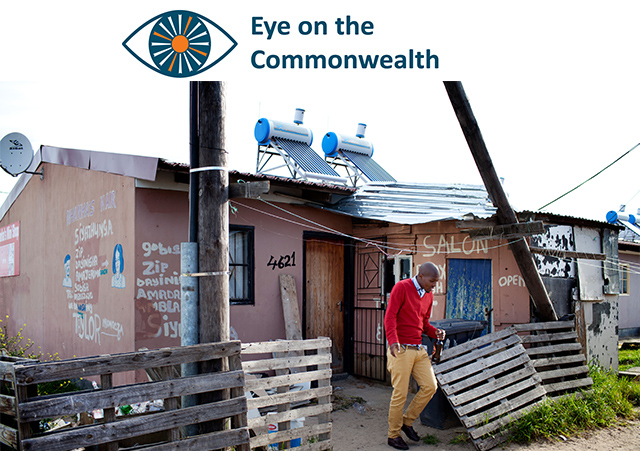 Cape Town: A man stands outside his home salon in a newly developed RDP housing project in Langa where all houses are provided with solar power. [picture: Africa Media Online / Alamy]
Cape Town: A man stands outside his home salon in a newly developed RDP housing project in Langa where all houses are provided with solar power. [picture: Africa Media Online / Alamy]
The lights are going out across South Africa – and no one can be quite sure when they will see them lit again. Africa’s most industrialised nation is in the grip of a worsening energy crisis that has seen rolling blackouts last for up to 10 hours a day. The ‘load-shedding’ imposed by the flailing state power utility company, Eskom, in turn prevents pumping stations supplying water, closes bars and restaurants, leaves streets dark, farmers unable to irrigate crops and bodies decomposing in morgues.
It is a far cry from 2010, when South Africa joined Brazil, Russia, India and China as one of the Brics – the term for the ‘alternative G7’ of emerging economic superpowers coined by a Goldman Sachs economist, Jim O’Neill, in 2001. South Africa now languishes at the foot of the IMD ranking of international competitiveness – in 60th place out of 63 countries. It has a multitude of problems: high unemployment, with more than a third of young people without a job; soaring public debt levels; no apparent strategy to address deep-rooted socio-economic structural problems; and a continued failure to address the corruption and ‘state capture’ exemplified by the disgraced former president Jacob Zuma.
South Africa: Stumbling from crisis to crisis
South Africa’s New Hope Faces Daunting Challenges
Commonwealth Update: South Africa and Eskom
Ten-hour blackouts
But probably top of the many crises facing President Cyril Ramaphosa is the paralysing effect South Africa’s crippled energy infrastructure has had on the economy, which is teetering on the brink of recession after months of power cuts. As the southern hemisphere winter begins to bite, with the prospect of temperatures falling to below zero in some places, Eskom has warned that the current 10-hour blackouts will not be enough to prevent complete collapse and 16 hours of outages will be needed every 32 hours.
Eskom can only guarantee supplies of 27,000 megawatts, too little for the summer and far below the winter peaks. Kgosientsho Ramokgopa, the electricity minister and an engineer by training, admitted: ‘I’ll be brutally honest – it’s going to be an exceptionally difficult winter. We know that in summer conditions, the deficit is 6,000 megawatts. When we go into winter, the peak can go up to 37,000 megawatts. But at the current rate of trips and failures, it’s going to be an exceptionally difficult winter.’
It is a sorry tale of rampant corruption, blatant theft, gang warfare and sabotage of an antiquated electricity grid. It has even involved an alleged plot to poison Eskom’s chief executive. A national state of disaster was declared in February to give legal weight to efforts to address the problem; but the state of disaster was revoked after barely two months, even though the electricity supply had not improved. Meanwhile, the National Treasury told the indebted Eskom that it could not borrow any more funds for three years and it had to find the resources for repairs on its own. Eskom’s chairman, Mpho Makwana, said it would take 18-24 months to end the blackouts.
‘Eye on the Commonwealth’ columns look at current issues facing the Commonwealth
Find out more about the Commonwealth Round Table and the Round Table Journal
Little renewable capacity
Four-fifths of the country’s energy generation relies on old coal-fired plants and it is a very high emitter of carbon – China and South Africa emit more greenhouse gases than the entire developed world combined. Remarkably, for a country with a daily average of seven hours of sunshine, it has comparatively little renewable energy capacity: in 2020 the electricity generated from renewables amounted to a mere 10.5% of the South African national total.
It wasn’t supposed to be like this. In his 2012 State of the Nation address, Zuma promised a ‘massive infrastructure development drive’. He pledged that: ‘To increase energy capacity, we will continue searching for renewable energy sources, especially solar electricity and biofuels.’ By 2017, his Nine-Point Plan claimed South Africa had ‘a stable and reliable supply of electricity’ with ‘excess capacity’.
That may finally be starting to change, with 1,300MW of new solar and wind projects registered with the energy regulator in March – a monthly record and equivalent to about 75% of all projects registered in 2022. It is up 800% on the total of 134 projects registered in 2021. There may be light at the end of the tunnel for South Africa’s hard-pressed citizens.
Oren Gruenbaum is a member of the Round Table editorial board.



